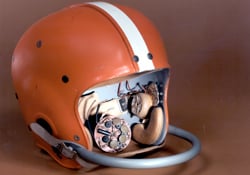Most people are aware that radio communication is used everywhere in the NFL. Coaches all wear microphones with headsets. They send play calls onto the field through the radio receivers in the quarterbacks’ helmets.
It would be reasonable to think that this high-tech approach is a relatively new thing, but it isn’t. Radio helmets go back a long way in the NFL!
How The Football Helmet Radio Was Invented
Back in the 1950s, legendary Cleveland Browns coach Paul Brown was known for being an innovator.
He was a pioneer in the practice of having coaches call the plays. Before Brown, the quarterbacks called the plays and set the offensive strategy.

Brown invented a system where a pair of guards would alternate plays. One of the guards would bring in the call when he ran onto the field. Meanwhile, the other guard ran over to the coach to get the call for the next play.
Psst – keep it secret
In 1956, two inventors and Browns fans named George Sarles and John Campbell came to Brown with an invention they thought he could use.
The duo had devised a small radio receiver that could fit inside a football helmet.
Brown liked the idea but wanted them to test it more thoroughly. He also wanted it to be a secret.
The Browns’ new quarterback, George Ratterman, gave his helmet to inventor John Campbell.
Out in the woods

Campbell took the helmet back to his secluded home that was surrounded by woodland. His pal George Sarles donned the helmet and went out into the woods.
Campbell stayed at his house and monitored the radio signal. After a while, the signal weakened and died.
When Sarles didn’t return, Campbell began to worry and went into the woods to find him. This has all the hallmarks of a horror film! And yes, the police did get involved.
When Campbell found his co-inventor, the helmeted Sarles was being confronted by a confused police officer.
We’re innocent!
It just so happened that their signal had broken in on the police frequency. Their transmission had burst in on his radio as he drove by!
Naturally, the local cop was suspicious of a helmeted man wandering around in the woods. But the pair weren’t master criminals and they came clean. They confessed the full story to the officer.
So much for keeping secrets! However, it turned out that the officer was a massive Browns fan. He loved the idea of his team getting an advantage and agreed to keep the secret.
Campbell and Sarles also agreed to change the frequency of the radio!

First Use Of Ratterman’s Radio Helmet
The first time the radio helmet was used was against the Detroit Lions in 1956. Ratterman wore the radio helmet and d it worked perfectly.
However, the Lions’ coaching staff noticed early on that Brown wasn’t using his usual relay system to send plays in.
One of the Lions’ assistants was sent to reconnoiter the Browns sideline and quickly spotted the transmitter hidden behind a light pole.
With this, the cat was out of the bag and there was an immediate controversy. But Coach Brown steadfastly ignored all complaints.
Other teams soon rushed to get their own radios. There were rumors that some bought radio jammers as well!
The Brown’s radio experiment lasted for a total of four games, with varying degrees of success. So, why was it stopped?
Radio Helmets Are Banned

Before a game against the New York Giants, Brown publicly warned the Giants that any attempt to jam his signals would violate FCC law.
The Giants complied with Brown’s demands and didn’t attempt to jam the radio signal. However, the canny New Yorkers simply listened in to the communications!
The Giant’s offensive coordinator was Vince Lombardi. He would go on to become one of the greatest head coaches in the NFL. But back then, he was just a very clever assistant coach.
Lombardi assigned a backup player to sit at the radio set and listen to the calls. He, in turn, passed the call on to a former Browns player who translated it for defensive coordinator Tom Landry.
Landry then signaled the call to defensive end, Andy Robustelli, on the field.
As a result, the Giants won the game by a score of 21-9. So, the radio innovation completely backfired on Cleveland.
The whole concept was turning the NFL into a farce. The commissioner had seen enough!
A few days after this fiasco, NFL commissioner Bert Bell banned radio receivers in helmets.
Ratterman’s radio helmet was retired for good. It’s currently on display in the Pro Football Hall of Fame in Canton, Ohio. It was donated for display by inventor John Campbell.
Radio Helmets In The Modern Era

Why did radio helmets return to the NFL in the 1990s? Let’s go back to 1994.
In 1994, the NFL was looking for ways to speed the game up.
One of the rule changes they made was to shorten the amount of time on the play clock. The play clock measures the amount of time teams are allowed to take between plays.
This change definitely sped up the game. But suddenly teams had trouble getting the play called and the ball snapped in time. They were having to use their time-outs just to avoid delay of game penalties.
Return of the radio helmet
In response to this, the league again allowed the quarterback to have a radio in his helmet. It was up to the teams to pick their own systems, with mixed results.
For years, the San Francisco 49ers had a famously bad system that would cut out, give bursts of static, and occasionally pick up airline or military transmissions!
One coach from that period describes looking out on the field and seeing his quarterback swatting at his head like he was being swarmed by flies. The poor guy’s helmet was continually giving off a strange buzzing noise!
Still, no one chose to stay with the old system.
Super Bowl-winning coach Brian Billick said that the amount of time he used to have to spend figuring out systems to get the play call to the quarterback was huge. It was a massive relief to him just to have the radio.
Current version

In 2012 the league switched from analog to digital communications. This brought a big improvement in reliability.
One of the funny side effects of helmet radios is that you now constantly see the coaches covering their mouths with a clipboard.
This is literally so that lip readers hired by the other teams can’t steal the call as they are speaking into the headset to their quarterback!
What Is The Green Dot On A Quarterbacks Helmet?
If you look closely, every quarterback in the NFL has a green dot sticker on the back of his helmet.
This dot indicates the player with the radio helmet.
Up until 2008, only the quarterback was allowed to have the receiver, but now one defender can as well. Defenders were allowed to have a radio as well after the infamous Spygate controversy.
Spygate was where the New England Patriots were accused of using videotape to steal the opposing team’s defensive signals.
Because defenses substitute more players, the defense actually has three players with radio helmets. Only one can be on the field at a time.
How The System Works Today
There are a few very simple rules about how the system works today.
Only one player from each team can be on the field with the radio helmet at a given time.
Only the sideline coaches can talk to the player on the field. Coaches up in the booth can’t be involved in radio communication.
The frequency shuts off 15 seconds before the play clock runs out.
Finally, if one team’s radio system fails, the other team has to shut theirs off until it can be fixed.
More About Football History
Now you know about radios in helmets. But did you know that helmets themselves weren’t made mandatory in the NFL until 1943?
Check out our article on the history of helmets in American football.
Back in the 1950s when radio was first tried, another piece of gear was becoming more widely used. You may be surprised that plenty of players didn’t like wearing shoulder pads in the 1930s and 1940s.
It was the shift of leather to plastic that finally made them popular. Check out our article on the history of shoulder pads in American football.